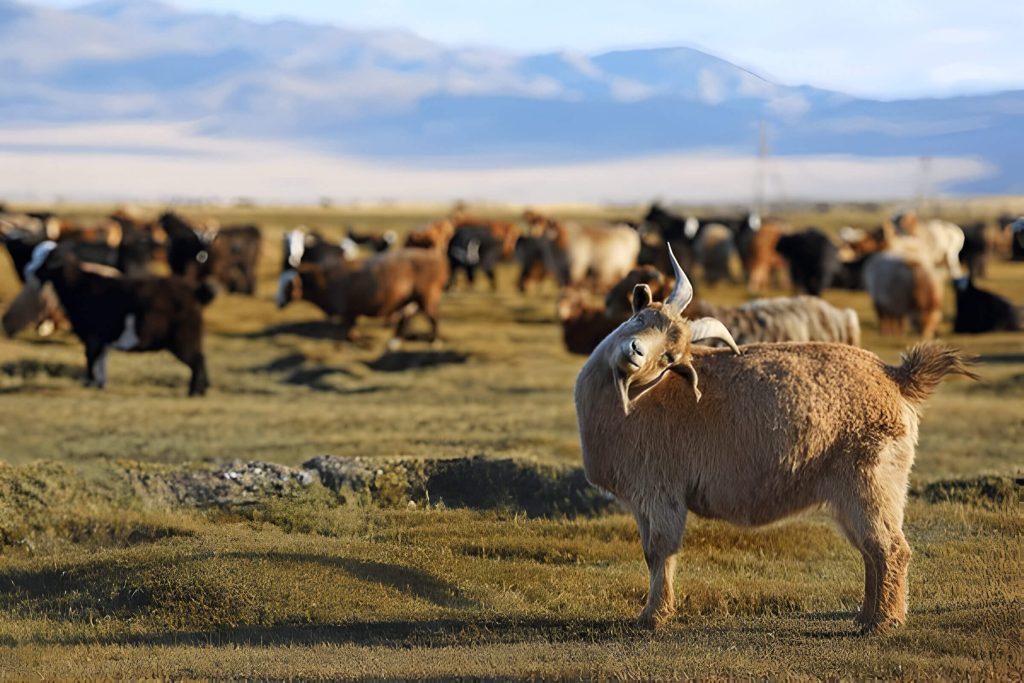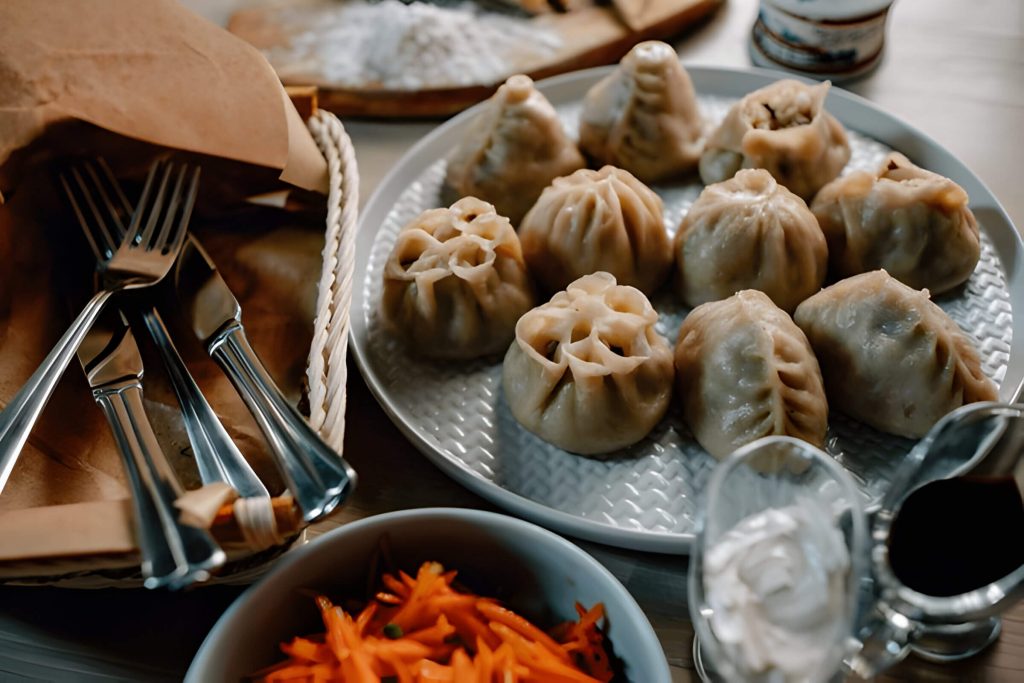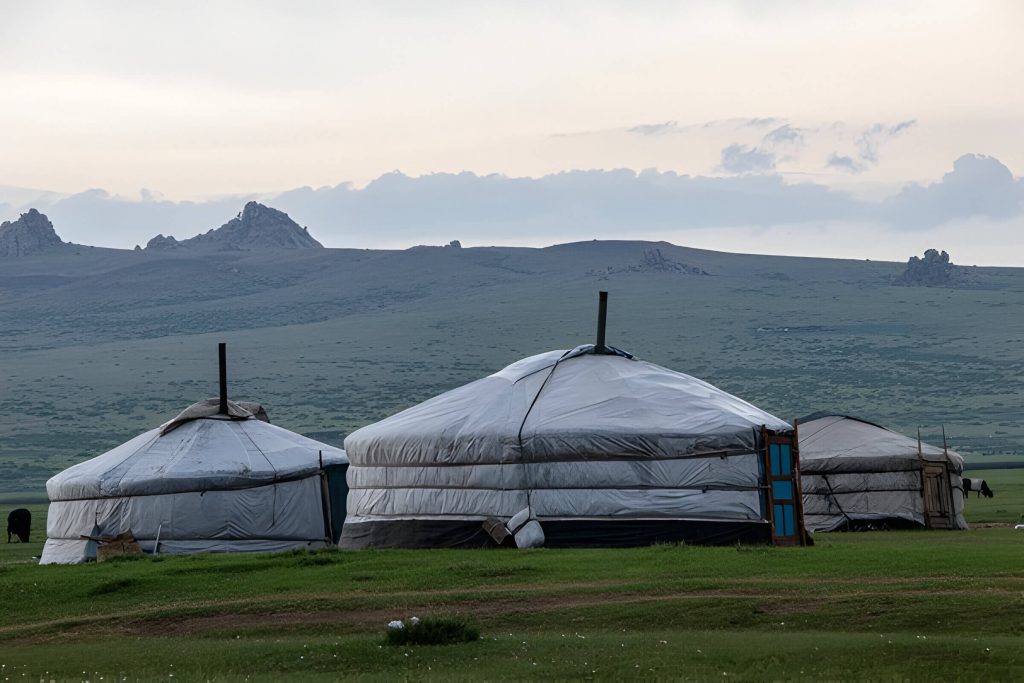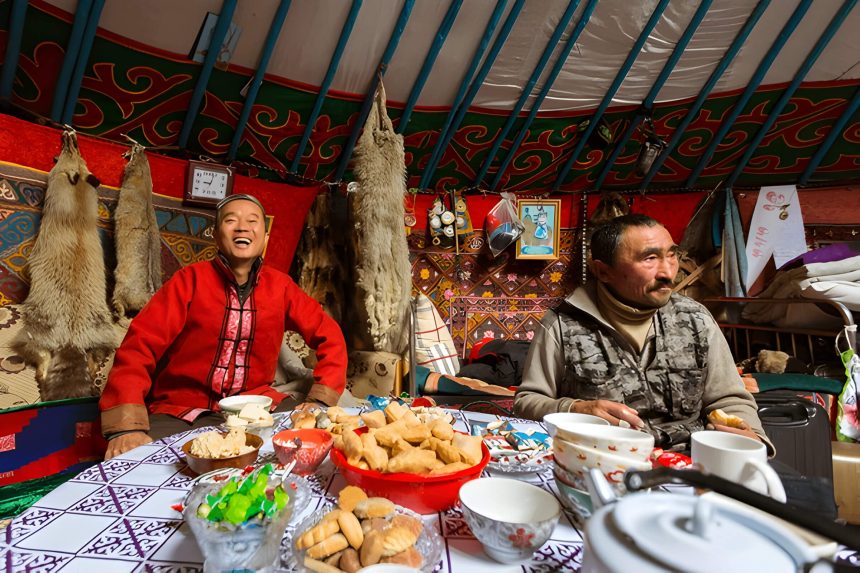The Mongolian diet reflects centuries of nomadic tradition, shaped by harsh landscapes and resourcefulness. Centered on meat and dairy, it showcases the ingenuity of a people thriving in challenging environments. From fermented mare’s milk to stone-cooked meat dishes, Mongolian cuisine embodies cultural significance and social traditions. As Mongolia balances preserving its culinary heritage with modern influences, its diet continues to evolve, illustrating the interplay of culture, geography, and nutrition.
The Historical Roots of Mongolian Cuisine
Mongolian cuisine has deep roots in the country’s nomadic heritage, shaped by centuries of life on the vast steppes. The traditional diet of Mongolian nomads was heavily influenced by their pastoral lifestyle and the harsh climate of the region.
Historically, Mongolian food centered around meat and dairy products, which were readily available from their herds of livestock. Mutton, beef, and horse meat were staple proteins, often prepared through boiling or roasting. The ancient eating habits of Mongolians also included the consumption of milk products like airag (fermented mare’s milk) and aaruul (dried curds).
The steppe culture significantly impacted food preservation techniques. With limited access to vegetables and grains, Mongolians developed methods to store meat and dairy products for long periods, such as making borts (air-dried meat strips) and various forms of cheese.
Traditional Mongolian food preparation methods were simple yet effective, designed to be practical for a nomadic lifestyle. One-pot dishes like khorkhog (mutton cooked with hot stones) and buuz (steamed dumplings) became popular, as they were easy to prepare in portable settings.
This pastoral diet, rich in protein and fat, was well-suited to the energy demands of nomadic life and the cold climate. Today, while modern influences have diversified Mongolian cuisine, these historical roots continue to play a significant role in the country’s culinary identity.
Key Components of the Mongolian Diet
The Mongolian diet is characterized by its unique composition, heavily influenced by the country’s nomadic heritage and harsh climate. Meat-based dishes form the cornerstone of Mongolian cuisine, with mutton, beef, and horse meat being particularly prevalent. These protein-rich foods are often prepared through boiling or grilling, providing essential nutrients for survival in the challenging Mongolian environment.
Dairy products play a crucial role in the diet, with fermented milk products like airag (fermented mare’s milk) and aaruul (dried curds) being both nutritious and culturally significant. These fermented foods not only offer probiotic benefits but also serve as a means of preserving milk in a country with limited refrigeration.
Vegetables are relatively scarce in traditional Mongolian cuisine due to the country’s short growing season and nomadic lifestyle. However, root vegetables like potatoes and carrots are sometimes incorporated into dishes when available.
Staple grains, primarily wheat and barley, are used to create various foods such as noodles and dumplings. These carbohydrate sources complement the protein-heavy diet and provide necessary energy for daily activities.
Understanding these key components of the Mongolian diet offers insight into the country’s culinary traditions and the adaptive nature of its cuisine to the unique geographical and cultural landscape.
The Role of Livestock in Mongolian Nutrition

Livestock plays a crucial role in Mongolian nutrition, serving as a primary source of protein and essential nutrients for the population. Mutton, beef, horse meat, yak, and goat are staple foods in the Mongolian diet, each offering unique nutritional benefits. Mutton, rich in iron and B vitamins, is the most commonly consumed meat, while beef provides high-quality protein and zinc. Horse meat, although less common, is prized for its lean profile and omega-3 fatty acids. Yak meat, particularly popular in mountainous regions, is known for its high protein content and low cholesterol levels. Goat meat, often used in traditional dishes, is a lean option rich in vitamins and minerals.
Mongolian herders have long practiced sustainable farming methods, allowing them to maintain healthy livestock populations while preserving the fragile ecosystem of the steppes. These traditional practices, passed down through generations, ensure that the animals are raised in a natural environment, resulting in high-quality, nutrient-dense meat. By rotating grazing areas and adapting to seasonal changes, Mongolian herders maintain a delicate balance between their livestock needs and environmental conservation.
As Mongolia faces challenges from climate change and modernization, preserving these sustainable farming practices becomes increasingly important. Not only do they contribute to the nutritional well-being of the population, but they also help maintain the country’s unique cultural heritage and ecological balance.
Dairy Delights (From Airag to Aaruul)
Mongolian cuisine boasts a rich array of dairy products that have been integral to the nomadic lifestyle for centuries. At the heart of this dairy-centric diet is airag, a mildly alcoholic beverage made from fermented mare’s milk. This tangy, effervescent drink is not only refreshing but also packed with probiotics and essential nutrients.
Another staple in the Mongolian diet is aaruul, or dried curds. These chewy, protein-rich snacks are made by drying yogurt or sour milk in the sun, resulting in a portable and long-lasting food source. Aaruul comes in various flavors and textures, from sweet to sour, and soft to rock-hard.
Mongolian cheese, known as byaslag, is another dairy delight that showcases the versatility of milk in this cuisine. Made from cow, yak, or sheep milk, byaslag has a firm texture and a mild, slightly salty taste. It’s often consumed fresh or used in traditional dishes.
Yogurt, or tarag, is a common ingredient in Mongolian households, used both as a standalone food and as a base for other dairy products. Its creamy texture and tangy flavor make it a versatile addition to many dishes.
No discussion of Mongolian dairy would be complete without mentioning suutei tsai, or milk tea. This comforting beverage, made with milk, tea, and sometimes salt, is a daily staple that reflects the importance of dairy in the Mongolian diet and culture.
Traditional Mongolian Dishes and Their Significance

Traditional Mongolian cuisine reflects the country’s nomadic heritage and harsh climate, with dishes that are hearty, nutritious, and deeply rooted in cultural significance. Buuz, steamed dumplings filled with seasoned meat, are a staple during celebrations and the Lunar New Year. Khorkhog, a mutton dish cooked with hot stones, exemplifies the resourcefulness of nomadic cooking methods. Boortsog, fried dough often served with tea, represents hospitality and is offered to guests as a sign of welcome.
Tsuivan, a noodle dish with meat and vegetables, showcases the influence of neighboring cuisines while maintaining a distinctly Mongolian flavor profile. Urum, a thick clotted cream, is not only a delicacy but also symbolizes abundance and good fortune. These dishes, among others, play a crucial role in Mongolian social gatherings, religious ceremonies, and daily life, serving as a tangible link to the country’s rich cultural heritage.
The cultural importance of food in Mongolia extends beyond mere sustenance; it embodies centuries of tradition, survival skills, and communal bonds. As Mongolia modernizes, these traditional dishes continue to be cherished, adapting to contemporary tastes while preserving their historical significance.
The Impact of Seasons on Mongolian Eating Habits
Mongolia’s harsh climate and distinct seasons significantly influence the country’s eating habits, creating a unique culinary landscape that adapts to environmental changes. During the brief summer months, Mongolians take advantage of the abundance of fresh ingredients, incorporating a variety of vegetables, fruits, and dairy products into their diets. This period is crucial for harvesting and preserving food for the long winter ahead.
As temperatures plummet and the landscape becomes barren, Mongolians rely heavily on winter preservation techniques. Traditional methods such as drying, fermenting, and smoking meat and dairy products ensure a steady food supply during the colder months. The iconic aaruul, a dried curd, is a prime example of how Mongolians transform summer’s dairy surplus into a nutritious winter staple.
Seasonal ingredients play a vital role in Mongolian cuisine. Spring brings tender wild onions and garlic, while autumn yields an array of berries and nuts. These fleeting delicacies are eagerly incorporated into meals and preserved when possible. The adaptability of Mongolian eating habits is evident in their ability to create nourishing dishes from limited ingredients during winter, often relying on meat, flour, and preserved foods.
This seasonal approach to food not only reflects the country’s traditional nomadic lifestyle but also demonstrates the resourcefulness and ingenuity of Mongolian culture in the face of challenging environmental conditions.
Modern Influences on the Mongolian Diet
The traditional Mongolian diet, once centered around meat, dairy, and limited vegetables, has undergone significant changes in recent years due to various modern influences. Urbanization has played a crucial role in reshaping dietary habits, as more Mongolians move to cities and adopt urban lifestyles. This shift has led to increased consumption of processed foods and a decline in traditional nomadic eating patterns.
Globalization has also left its mark on Mongolian cuisine, introducing a wide array of imported foods and international flavors. Supermarkets in urban areas now stock products from around the world, exposing Mongolians to diverse culinary options. This influx of foreign foods has contributed to changing dietary patterns, with many people incorporating new ingredients and dishes into their daily meals.
The availability of imported foods has both positive and negative implications for Mongolian nutrition. While it has increased dietary variety and access to fruits and vegetables year-round, it has also led to higher consumption of sugary drinks, snacks, and fast food. These changes have raised concerns about the potential health impacts, including rising rates of obesity and diet-related diseases.
As Mongolia continues to modernize, finding a balance between preserving traditional food culture and adapting to global influences remains a challenge. Nutrition experts and policymakers are working to promote healthy eating habits that incorporate both traditional and modern elements, ensuring that the evolving Mongolian diet supports the population’s health and well-being.
Health Implications of the Traditional Mongolian Diet
The traditional Mongolian diet, characterized by its high protein content and limited consumption of fruits and vegetables, has significant health implications for those who follow it. This dietary pattern, shaped by the country’s harsh climate and nomadic lifestyle, primarily consists of meat, dairy products, and animal fats.
While the high protein intake can contribute to muscle maintenance and satiety, it may also pose risks to cardiovascular health when consumed in excess. Studies have shown that diets rich in red meat and animal fats can increase the risk of heart disease and certain types of cancer.
The limited intake of fruits and vegetables in the traditional Mongolian diet can lead to various nutrient deficiencies. These plant-based foods are essential sources of vitamins, minerals, and fiber, which play crucial roles in maintaining overall health and preventing chronic diseases.
Researchers have observed higher rates of certain health issues among populations following this diet, including increased blood pressure and cholesterol levels. Additionally, the lack of dietary fiber may contribute to digestive problems and an increased risk of colon cancer.
To mitigate these health risks, nutritionists recommend incorporating more plant-based foods into the diet while maintaining moderate protein intake. This balanced approach can help preserve cultural traditions while addressing potential nutritional gaps and promoting long-term health.
Preserving Culinary Heritage in a Changing World
Preserving culinary heritage has become increasingly important in our rapidly changing world. Food festivals play a crucial role in this preservation effort, offering a platform for communities to showcase their traditional dishes and cooking techniques. These events not only celebrate local flavors but also educate visitors about the cultural significance of various cuisines.
Culinary tourism has emerged as a powerful tool for preserving food traditions. Travelers seeking authentic experiences are drawn to destinations known for their unique gastronomic offerings, encouraging local communities to maintain and promote their culinary heritage. This interest from outsiders often reignites pride in traditional foods among locals, further strengthening cultural identity.
The practice of passing down recipes from one generation to the next remains a cornerstone of culinary preservation. Families and communities are recognizing the importance of documenting and sharing their traditional recipes, ensuring that future generations can continue to enjoy and prepare these dishes. Many are turning to digital platforms to record and disseminate their culinary knowledge, making it more accessible to a wider audience.
As globalization continues to influence food trends, preserving culinary heritage becomes essential in maintaining cultural identity. Traditional foods often carry deep historical and social significance, serving as a tangible link to a community’s past. By actively working to preserve these culinary traditions, we not only safeguard an important aspect of cultural heritage but also promote diversity in our global food landscape.
The Mongolian Diet as a Window into Nomadic Culture and Adaptation

The Mongolian diet offers a fascinating glimpse into the resilience and adaptability of nomadic cultures. Shaped by harsh climatic conditions and a mobile lifestyle, this diet reflects centuries of traditional wisdom and practical necessity. Rich in protein and animal fats, it has sustained generations of Mongolians through extreme temperatures and challenging terrains.
While the diet may seem limited by modern standards, it demonstrates remarkable efficiency in utilizing available resources. The emphasis on dairy products, meat, and fermented foods not only provides essential nutrients but also showcases ingenious preservation techniques developed to combat food scarcity.
Moreover, the Mongolian diet serves as a testament to the deep connection between people, their environment, and their cultural practices. It highlights how food choices are intrinsically linked to lifestyle, geography, and historical context.
As global interest in diverse culinary traditions grows, the Mongolian diet offers valuable insights into sustainable food practices and the importance of cultural preservation. It reminds us that dietary habits are not just about nutrition, but also about identity, tradition, and adaptation to one’s environment.
In conclusion, studying the Mongolian diet provides a unique window into nomadic culture, offering lessons in resourcefulness, sustainability, and the profound relationship between food and way of life.
